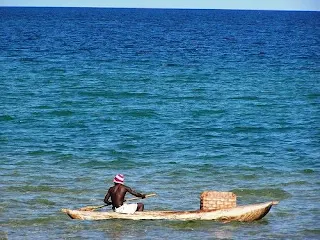How Lake Malawi Was Made
Lake Malawi is incredibly old, estimated to be around 1-2 million years old. It's one of the world's oldest, clearest, deepest lakes. Lake Malawi, nestled in the East African Rift System, was created by geological processes involving tectonic activity and filling a depression with water.
 |
| Lake Malawi |
How Lake Malawi Was Made
The formation of Lake Malawi is intimately linked to the geological phenomena of tectonic activity. About 35 million years ago, the African continent experienced significant tectonic shifts. These movements created a colossal rift, or a fracture, in the Earth's crust. This massive geological event is part of what is known as the East African Rift System.
The East African Rift System, a geological wonder, stretches over 3,000 miles from the Red Sea in the north down to Mozambique in the south. It's a split in the African continent, resembling a seam where two tectonic plates pull apart. This process continues, causing the African continent to slowly split into two smaller land masses.
This rift formed, creating a low-lying depression on the Earth's surface. Over time, this depression began to accumulate water. Over millions of years, rainfall played a significant role in filling the basin, and numerous rivers flowing into the area contributed to the lake's formation.
The tectonic activity in the region not only created the depression but also influenced the lake's depth. The earth's crust being pulled apart contributed to the lake's depth, as the land sank along the rift. This geological process, which is still ongoing, continues to shape the lake's depth. Lake Malawi is the third deepest in the world and occupies an elongated crack of the Rift Valley.
Lake Malawi reaches impressive depths, with its maximum depth exceeding 2,300 feet or about 700 meters. To put this into perspective, that's deeper than the Empire State Building is tall. This exceptional depth is one factor that makes Lake Malawi stand out among the world's lakes.
Lake Malawi is famous for its exceptional biodiversity. It's home to a diverse range of fish species, many of which are found nowhere else on Earth. This is due to the lake's long isolation. The land surrounding Lake Malawi boasts a vast population of cichlid fish, numbering in the hundreds. All of the over 350 species in the lake, except for 5, are unique cichlids, making up 30% of all known cichlid species worldwide.
What's remarkable is that almost all of these fish species are exclusive to Lake Malawi, and they are affectionately referred to as mbuna or rockfish by the local residents. The mbuna fish provide a compelling illustration of biological evolution. This is because, owing to Lake Malawi's isolation from other bodies of water, its fish have undergone a remarkable process of adaptive radiation and speciation. This makes them a superb example of ecological processes in action.
Lake Malawi's islands, mainly Mumbo and Boadzulu, play a critical role as nesting sites for white-throated cormorants. The population of these birds is in the thousands, and these islands offer a secure and suitable habitat for them to breed and rear their young.
In addition to birdlife, the islands are home to various reptiles. Crocodiles, as formidable predators, can be found in the waters around these islands. Furthermore, Boadzulu Island is notable for its abundant population of monitor lizards, adding to the reptilian diversity of the region. Mammals in and around Lake Malawi include hippopotamus, duiker antelopes, baboons, vervet monkeys, bushpigs, and warthogs.
The shoreline of Lake Malawi is a fascinating fusion of rocky cliffs and sandy beaches. The lake's clear freshwater is often met by steep and rugged terrain, including elevated plateaus and hills. The pristine and transparent waters of Lake Malawi are a result of its isolation.
 |
| Dogs playing in Lake Malawi |
The isolation of Lake Malawi from other major water bodies also reduces the introduction of external contaminants, contributing to the clarity of the water. Also, the vast size of Lake Malawi, spanning approximately 11,400 square miles, allows for the natural dilution of any particles that may enter the lake. This large volume of water disperses impurities, helping to clear the water.
In addition, the lake's low nutrient levels play a crucial role. Clear water often means low nutrient content, limiting the growth of algae and other microorganisms that can cloud the water. This, in turn, helps maintain water clarity.
Lake Malawi is the most southerly of the great African Rift Valley lakes. Lake Malawi is bordered by three countries; Malawi, which takes its name from the lake, is the country that lies to the east of the lake. Tanzania shares its western shoreline, and Mozambique is situated to the lake's east and south. The East African Rift System, where Lake Malawi is situated, is home to Lake Victoria, Lake Tanganyika, Lake Albert, Lake Edward, and Lake Kivu.







